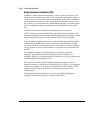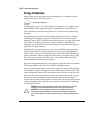
G
lossary-2
boot – To start up a computer. During the start up process, information necessary
for the computer to operate is loaded into the memory.
browser – A program used to access and view information. See Web browser.
bug – An error in computer program code.
bulletin board – A computerized meeting and announcement system that can be
accessed directly by dialing the bulletin board system telephone number using a
modem or through an ISP connection and the Internet.
bus – The main communication path used by the components of a computer.
byte – A unit of measurement used to describe a quantity of data, equal to eight
bits. A character is one byte in size. See bit.
CAB files (CABinet files) – Files in the Windows directory on your hard disk that
contain the Microsoft Windows operating system distribution files. These files are
automatically accessed when necessary.
cable modem – A device that provides constant access to the Internet through a
cable Internet service provider.
cache – A portion of memory where frequently used information is duplicated for
the purpose of instant access. See memory.
CardBus PC Card – A 32-bit PC Card. See PC Card.
CD – See compact disc, digital versatile disc, digital video disc.
CD-ROM – See compact disc.
central processing unit (CPU) – Controls the operation of a computer. Arithmetic
and logic operations, as well as the decoding and execution of instructions are
performed by the central processing unit. See chip, microprocessor.
channel – A communication path.
Channel Bar – A feature of the Microsoft Windows 98 active desktop that
provides single-click access to featured Web sites.
chip – A tiny silicon wafer that contains miniature transistors and circuits. See
central processing unit, microprocessor.
client – A computer workstation on a network that has access to the data and
services of a central computer known as a server. Contrast server.


















